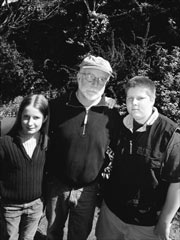IT WAS A SCHOOL DAY early last November. The piano teacher was baffled. The mother had dropped off the student for her one-hour lesson at 7:45 a.m. but hadn’t picked her up as usual. It wasn’t like Donna O’Steen to not do what she said she was going to do.
The piano teacher took her next student, and the freckle-faced 11-year-old girl, Morgan Haynie, waited.
After the second lesson and repeated calls to O’Steen that went unanswered, the teacher drove the girl the few blocks to the comfortable but not ostentatious house on the bluff overlooking Shilshole Marina.
The worried piano teacher and Morgan arrived at the house at about 9:30 a.m. O’Steen’s Audi, its engine still warm, was parked in the driveway. They tried all the doors and knocked loudly. There was no answer.
“There’s a key in the garage,” Morgan said.
Donna O’Steen: mother of Morgan and 13-year-old son Kealan; wife of Rich Haynie. She was an attractive, busy, middle-class 53-year-old, deeply involved in family and community. She worked a few hours on weekdays in the small family boat-insurance business on Lake Union. She’d had an adventurous life. She’d raced sailboats, had sailed twice to the South Pacific with her first husband, Jim O’Steen (a founding partner of the Harvard Exit, the art-film theater). He died in 1983, and she married Haynie, another self-described “sail bum.” They were part of a tight-knit community of sailors belonging to the Sloop Tavern Yacht Club at Shilshole—not a fancy see-and-be-seen club, but one of cold beer, wooden ships, and iron sailors. They tied up their boats to raise kids, but Donna kept her beloved green-and-white sloop, the Renaissance, shipshape for after their kids grew up.
Morgan and the piano teacher went to the garage, a separate building outside the yard. Five minutes later, they were back at the front door; they turned the key in the lock, but the safety latch was shut, allowing the door to open only partway.
“We never use that lock,” Morgan said.
They called out to O’Steen through the crack. There was no answer. Very worried now, the piano teacher and Morgan went to a neighboring house and got the landscaper who’d been waiting to trim a tree for the Haynies. He went with them back to the house.
Behind a modest wrought-iron gate that’s never locked sits the Haynie/O’Steen home and Donna’s small but lovely garden. Hidden from the roadway on a cul-de-sac, there’s
no lawn but an eclectic collection of rhodies, camellias, and pampas grass in whiskey barrels; it’s shady with a lacy Japanese maple and a large pine twisted by the winds off Shilshole Bay. They bought this house and lot before it was expensive. Over the years, they’ve added a second story and decks that hike out from the front windows. Their lives are lived facing the water upon which they’ve spent so many years.
Morgan tried again to call Donna through the front door, then the three went around to the side door on the deck off the kitchen; they were astounded to see that the door, locked tight only minutes before, was standing open.
They entered the house. The landscaper made the teacher and Morgan wait at the door while he went further in. As soon as he got into the house, he says, “I was terrified.” The sense of dread was palpable, raising the hairs on his neck.
“I knew there was something very wrong,” he says. There were spots of blood on two of the middle steps. It looked like makeup at first, the spots about the size of a dog’s paw print if it was bleeding, but it didn’t make sense for them to be midstair and nowhere else. He carefully went to the top of the stairs. There were some signs of a disturbance—a piece of clothing on the floor, the TV on its side.
Thinking the bad guy might still be there, he got out fast. He ran up the hill to fetch a neighbor, the friend with whom he’d been chatting earlier. “He came flyin’ up here,” says the neighbor. ‘Hey,’ he said, ‘there’s something wrong.’ We went down.”
Sunset Hill is an unpretentious, once-Scandinavian area on the top of the hill in northwest Ballard. There are many modest WWII bungalows, an abundance of what used to be known as “ramblers.” This was once a blue-collar neighborhood, and though there’s been little upscaling, things have changed. As the older Norwegians die off, younger folks come, bringing their kids and DSL connections. There are Explorers in driveways where once there were piles of gill nets. There are few extravagant homes up here; the village at 32nd and N.W. 65th has no fancy neighborhood restaurants. It’s all utilitarian—a video store, a lawn mower repair place, and a beauty shop where little old ladies still come for a weekly wash and set. It’s quiet: By day, seagulls squawk, starlings jabber, and crows forewarn; at night, the sea lions bark from Shilshole Bay. Old folks get their sleep, teenagers complain it’s too boring.
The two men went cautiously up the stairs and froze in place just inside the bedroom. “I just looked around,” the neighbor says. “Jewelry-box drawers were pulled out and stacked up in disarray; costume jewelry dumped all over the bed. ‘Somebody’s been robbing the place,’ that’s what I thought.”
The piano teacher, a take-charge 60-ish gray-haired woman, went upstairs, cell phone to her ear, talking to the dispatcher at 911. “She waltzed right by us into the bedroom,” says the landscaper, “and I heard her say, ‘She’s tied up and she’s dead on the floor.'”
O’Steen talked to her sister at 8:30 a.m. She hung up to make lunch for Morgan. Within an hour, she lay dead in the short, narrow passage between her bed and her bath. She was chest down, face turned toward the outside wall, hands bound behind her back with duct tape. She was fully clothed and had been viciously stabbed multiple times between her neck and abdomen. Two holes in the drywall were presumably made by her kicking. There wasn’t all that much blood—heavy pooling beneath her; spatters or smears in the bathroom and hall; smears where the killer paused to lean against window frames and look out in different directions, another on a bedroom door frame. The killer had cut the phone lines from the outside.
Apparently, he brought his own knife. “None of ours are missing,” says husband Rich Haynie. Though the police will not confirm nor deny anything, neighbors say the police have told them that the duct tape that bound her doesn’t match any that had been in the house.
Haynie thinks—at least on some days—that O’Steen knew her murderer and was comfortable letting him into the house. “But,” he says, “I can’t figure out why anyone would be so enraged at my wife.”
Neither can anyone else. While she was a strong, honest person, not afraid to speak up, she was well liked and had no known enemies or history of violent relationships.
“My wife was a very attractive woman,” Haynie says. “It might have been a stalker who’d been watching her all the time and finally got up the courage to come to the house.”
Was she having an affair that went bad? “She didn’t have the time for that,” says Haynie. O’Steen’s days were filled with family, kids’ school activities, and working in the family business.
Police, as always, have been tight-lipped about crime scene details and forensic evidence. Unlike everyone else, they won’t speculate. “It’s a possibility that it may have been a burglar,” police spokesperson Clem Benton told The Seattle Times, “and it’s a possibility that it may be random.”
REPORTING ON cases in which the full information has not yet been released is risky business: It can provide false or misleading information. Eyewitnesses know only what they saw, or less. Rumors and speculation hyperbolize the facts. It’s always possible, and often the case, that more comprehensive information has turned the police investigation in a different direction than what’s popularly conjectured.
Random murders are rare. The circle of suspicion in a murder investigation is concentric—the first suspects are those closest to the victim, and the investigation always starts with the spouse.
Rich Haynie started the day with a kiss from his wife and ended it not only with her dead, but also as the prime suspect in her brutal murder.
In the course of the following week, Haynie gave blood samples and fingerprints and passed a polygraph test. His status on the suspect list is now very low.
There are so many contradictions and unanswered questions. She was bound, so why murder her, unless it was a hit? Why was the phone line cut if she were to be killed? Why was the phone line cut if it was only a burglary? If it was an interrupted burglary, why did he murder her instead of running? Doesn’t bringing his own knife and tape suggest a premeditated killing? If it was a burglary, why wasn’t more taken? Haynie’s not sure what, if anything, was taken because the police haven’t asked him to compare what they took from the house to what might be gone. He says, “There’s not much missing.” The murderer didn’t take valuables that are easily grabbed and carried like O’Steen’s pearls, an emerald ring on her finger, or an Omega watch lying in sight.
Did she fight? People who knew Donna said she wouldn’t have gone down without a struggle. Kim Paxton, a fellow mom and close neighborhood friend, says, “She could have decked him, but she was [also] very verbal. She could put anyone in their place [and] she could talk herself out of something.”
Unfortunately, she didn’t. But as another neighbor noted, “Donna’s a fighter. If somebody’s ripping off her house, she’s gonna try and catch ’em—that could have been her demise.” Another neighbor said, “She could be sharp-tongued when she was right.”
Bob Goldsmith, a family friend and a criminal defense attorney, argues for the random killer theory. “You never know a person completely—so you never really know—but I don’t believe Donna had enemies of that sort. I think if it were someone who knew her, the police would have a potential list of suspects and it might be solved.”
The day of the killing, police served a search warrant on a ramshackle cabin below the Haynie home. Information was that the man who lives there might be a suspect. He was questioned and released.
Without the release of the results from the state crime lab, no one knows but the police if there were any strangers’ fingerprints or DNA found in the house. Often a knife-wielding attacker cuts his hands on his blood-slippery knife, leaving his own blood at the scene.
He must have been bloody—that no one saw him on foot is surprising. Dogs were brought in to track him, but neighbors claim the best bloodhounds weren’t brought to the scene in time to pick up a scent.
THE NEIGHBORHOOD was plunged into shock and horror. Mothers gathered up kids from school or met the bus. Doors never before locked in this serene neighborhood were double-bolted, alarm systems installed.
“The neighborhood was scared the killer was out there still,” says Goldsmith, “and of course, the killer was, and is, out there still.”
Cries went up to the cops for protection. Police cruisers began prowling the nondescript grid of Sunset Hill streets. A meeting at the community club a week after the murder put Seattle Police Sgt. Jay Mooney in front of an anxious, confrontational crowd demanding safety and more information. He had few real reassurances but disclosed that O’Steen was not sexually assaulted—information not usually made public. He said, “Gut instinct tells me” the crime would not be repeated in the neighborhood and that the killing did not “seem likely” to be the work of a serial killer. This, of course, were pure conjecture to sooth the citizenry. The police couldn’t know so early in the investigation that this wasn’t a pattern killing or that the murderer wasn’t lurking in the photinia, ready to strike again.
Serial murderers are hard to catch. Sometimes they choose so-called “disposable” populations—prostitutes, transients, the homeless—whose deaths aren’t as closely perused by police or media as those of such middle-class folks as Donna O’Steen. Their crimes, then, may never be linked or attributed to a single offender.
Police won’t comment, but some say they’ve brought in a profiler. They’re the detectives specially trained or experienced enough to stand back, get an overview, and look at the behavioral aspects of murders and rapes. They use behavioral psychology, computers, forensics, and experience. Silence of the Lambs and Profiler have mythologized profilers fantastically.
Profiling is cool, but it’s no panacea. Real-life profilers are not clairvoyant like they are on Millennium. Old-fashioned police work coupled with a good profile is a great crime-fighting tool, especially in cases like this, in which a motive is not clear.
A tool that’s improved linkage between serial crimes is the Homicide Information Tracking Unit (HITS), a database that cross-references murders, rapes, missing person reports, and the whereabouts of sexual predators and ex-convicts and contains the details of thousands of murders and rapes. It allows investigators to match common methods, details, and suspects in Washington and Oregon.
RICH HAYNIE and I were in the same high-school class (Ferndale, ’63). He was a congenial member of the pack of Lummi Island kids who always stuck together when they came to the mainland schools. He was an easygoing, quick-to-laugh kind of guy. He’s 56 now, but he’s aged—his trademark red hair and beard are white, his shoulders rounded. There’s an air of resignation about him; his pain is palpable. But he intrepidly treads through the days, doing what he has to.
The day of the murder, the cops held Morgan at a neighbor’s house, separated from him. She was freaked, knowing for hours that something was dreadfully wrong, but not, as she greatly feared, that her mom was dead. Her dad had to tell her what had happened. The police eventually let him go to pick up Kealan at Whitman Middle School. He had to tell his son, too.
His speech is now full of previously unthinkable phrases like “whoever killed my wife” or “Donna’s murder” or “when Donna died.”
The living area of the house is wrapped by windows from which you can see the white toothpick forest of the masts on boats in the marina; on Shilshole Bay beyond, boats scurry and chug by. In the house, the walls are covered with sailing memorabilia; there’s a model of a schooner and a glass cabinet full of shells Donna collected from southern beaches.
On the day I visit, Haynie is clearing out his belongings from the house he’d lived in for 15 years and thought he’d die in. His kids are in their rooms upstairs doing the same thing. It’s a sad job, packing up and hauling out a life. This easy space has been sullied in an obscene and unimaginable way.
“We love this house,” he says. “It has far more good memories than bad ones. But my daughter won’t live here, though my son and I think we could,” says Haynie. “After we go through a healing process for a while, I’d like to move back and try.”
There’s a golf putter within reach of each door here. It makes him feel safer but he won’t get out the guns that were stored away after a rural upbringing. “I’m too much of a liberal,” he says.
“I’m having more problems than my kids. I still can’t face it. It’s very hard to live with.”
TO MITIGATE that, the Haynies are counseled at Virginia Mason’s Separation and Loss Services, where families of the victims of homicide or other violent deaths can get help changing the grubby emotional landscape they’ve suddenly found themselves in.
Program director Lisa Drizenes says, “Families don’t ever get over this. They learn to accommodate to what’s happened, but there’s who they were before this happened and who they are now.
“When the perpetrator is not caught, it complicates their ability to take control of their personal safety. The public nature of homicide can become something that goes on and on in the papers and the court system. Those are some of the things that people who have anticipatory grief, accidental death, or suicide don’t have to deal with.”
Dr. Ted Rynearson is a psychiatrist and medical director of the clinic. His book Retelling Violent Death (Routledge, 2001) is a primer for the kind of intervention that works for this exaggerated kind of grief.
He sees the violent deaths as stories told to family members by themselves and others. He says, “Often when people come in for treatment, it’s because the violent dying story has eclipsed the story of the person’s living. Somehow the family members have to synthesize a restorative story for themselves that contains both of those narratives.”
Rich Haynie has been plunged not only into horror and grief but also into single parenthood. Right after the murder, the family packed some clothes and left; they’ve been camping in two bedrooms with in-laws in Richmond Beach. With help from relatives and neighbors, he’s succeeded in keeping his kids in their familiar Ballard schools, but the logistics of that and the kids’ activities make for long, complicated days. Donna played a daily role in his office, another gaping hole to be filled.
“We try to keep our life private,” Haynie says, “but I don’t want the public or the police to forget about my wife. Maybe somebody knows something and they’ll come forward. It’s a long shot, but there has to be more than the one or two people who killed her who know about this.”
“I thought I’d never forgive the Seattle Police for not letting me see my daughter” right after the murder, says Haynie. Their “bedside manner may leave something to be desired,” he adds, “but I’ll forgive them all that if they catch the asshole.”








